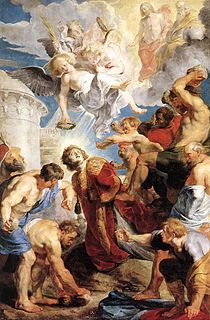 W
WThe 1476 Altarpiece or San Domenico Altarpiece is a 1476 tempera and gold on panel altarpiece by Carlo Crivelli. Its central panel of the Pietà is now in the Metropolitan Museum of Art in New York, whilst the other nine are now in the National Gallery, London.
 W
WThe Altarpiece of the Halberd is a painting from around 1539 by the Italian High Renaissance painter Lorenzo Lotto. It is housed in the Pinacoteca civica Francesco Podesti of Ancona, central Italy.
 W
WThe Burial of the Count of Orgaz is a 1586 painting by El Greco, a prominent Renaissance painter, sculptor, and architect of Greek origin. Widely considered among his finest works, it illustrates a popular local legend of his time. An exceptionally large painting, it is divided into two sections, heavenly above and terrestrial below, but it gives little impression of duality, since the upper and lower sections are brought together compositionally.
 W
WThe Spedalingo Altarpiece' or Ognissanti Altarpiece is a 1518 oil on panel painting by Rosso Fiorentino, now in the Uffizi in Florence, which acquired it in 1900. It was commissioned by Leonardo Buonafede, "spedalingo" of the Hospital of Santa Maria Nuova in Florence. The contract was dated 30 January 1518. The painting was intended for the St John the Baptist chapel in Ognissanti according to the will of Francesca de Ripoi, a Catalan widow.
 W
WSaint Stephen is a panel painting by Giotto, dating to around 1330–1335. It is painted in tempera on gold ground. It is in the collection of and serves as the logo of the Museo Horne in Florence.
 W
WThe Martyrdom of St Stephen is a c.1603-1604 oil on canvas painting by Annibale Carracci. It was given to Louis XIV by the duc de Montausier sometime before 1668 and is now in the Louvre in Paris. It is drawn on by a c.1610 work on the subject possibly by the artist's nephew Antonio Carracci.
 W
WSan Giovanni Evangelista is a church in Parma, northern Italy, part of a complex also including a Benedictine convent and grocery.
 W
WThe Saint Stephen Triptych is a 1616–1617 oil on panel painting by Peter Paul Rubens, produced as the high altarpiece for Saint-Amand Abbey, a Benedictine house near Valenciennes. It was seized during the French Revolution and is now in the Musée des Beaux Arts de Valenciennes.
 W
WThe Sermon of Saint Stephen is an oil-on-canvas by Italian artist of the Venetian school Vittore Carpaccio, painted in 1514. It is now in the Louvre in Paris.
 W
WThe Stoning of Saint Stephen is the first signed painting by Dutch artist Rembrandt, painted in 1625 at the age of 19. It is currently kept in the Musée des Beaux-Arts de Lyon.
 W
WThe Stories of St. Stephen and St. John the Baptist is a fresco cycle by the Italian Renaissance painter Filippo Lippi and his assistants, executed between 1452 and 1465. It is located in the Great Chapel of the Cathedral of Prato, Italy.
 W
WThe Suardi Chapel is an oratory or private chapel inside the villa in Trescore Balneario, Province of Bergamo owned by the Suardi counts. It is dedicated to Saint Barbara and Saint Brigid and was completely rebuilt by the cousins Giovan Battista and Maffeo Suardi. It is fully covered in 1524 frescoes commissioned by them from by Lorenzo Lotto of Christ the Vine and Lives of the Saints. In the 19th century count Gianforte Suardi built a corridor connecting the chapel to the villa and modified the chapel entrance - those entering had previously immediately found themselves in front of the north wall with its depiction of Christ the Vine.
 W
WThe Tornabuoni Altarpiece is a tempera on panel painting by Domenico Ghirlandaio and his studio as the high altarpiece for the Tornabuoni Chapel in Santa Maria Novella. It was begun around 1490 and completed around 1498, four years after the painter's death. It is now split between several museums, with the central panel and two others now in the Alte Pinakothek in Munich.